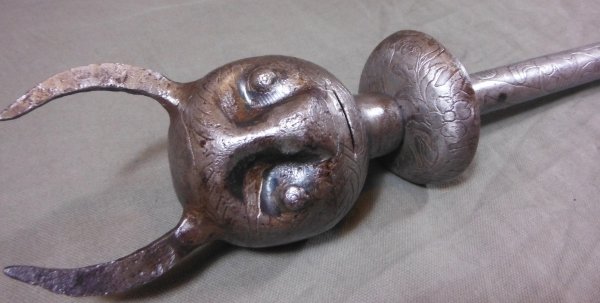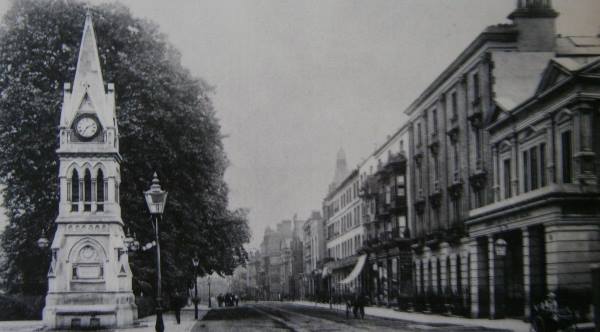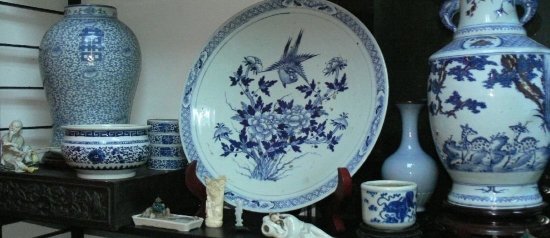I suppose it was because it was the first week in September and my year planner revealed that there was no arms fair to go to for a couple of weeks, that I decided that now was as good a time as any to set about clearing a room in the house that for several years had been my office, the room which the business had outgrown.
This room, with its view over the garden, contained some of the early additions to my library of books on arms and armour and it had long been a plan to locate these in one place, so that in future, when I was writing a description or answering a query, I could quickly and easily locate the information I needed.
It was when I moved a particularly weighty tome that a magazine cutting slid from its pages. It was a report on a London fair in the late 1970s with a somewhat younger me grinning into the camera, but, hey, back then all my colleagues looked younger too. Inevitably some of those colleagues, mentors from my early days, have gone.
A few seconds later there was a sliding sound followed by a crash. The large book I had removed had, for a couple of decades, been supporting the shelf above it, a narrow shelf not wide enough for books, into which I had shoved any thing smaller than a book… things like my boxes of card index files which now scattered across the already cluttered floor. This would have been a disaster of the first magnitude 20 years ago when they would all have to have been gathered up and re-filed, but today they could just be put straight into a bin bag for the bonfire. Inevitably some of the more dog-eared cards reminded me of customers and friends who, somewhere along the line, slipped unseen from the picture. As I took up the last handful of cards I uncovered the corner of a year planner and glancing at its full days I thought how much the arms and armour business has changed in the past 20 plus years and the position in which this field of collecting finds itself today.
Then, items were plentiful, some of that generation who had survived WW11 maybe looked back with nostalgia and wanted to develop an interest into a hobby. There was a profusion of books and there were collectors clubs. Some of the more serious of these developed into societies, one of which, in Stockport if I remember correctly, picked up an American trend and ran the first English Arms fair.
At these fairs, collectors would display their treasured collections to the public and, from the word go, wheeling and dealing between collectors began. There were already, of course, established antique arms dealers in London, but a new mobile breed from the younger generation emerged and very quickly people who had previously run collectors fairs jumped on the bandwagon and set up arms fairs around the country. Before long, as my year planner testified, there were fairs, sometimes two on a single weekend, in places such as Hull, Loughborough, Erdington, Oxford, Bristol, Cheltenham, Winchester, Leeds, Stockport Manchester, Chester and so on. At these fairs members of the public would bring in all manner of goodies. This plentiful supply was also reflected in the auction houses with the major London rooms: Christies, Sothebys, Phillips and Bonhams holding sales at least twice yearly. Smaller auctioneers around the country, realising the potential of arms and armour, held sales that you could only discover from local papers or specialist publications or by calling round for catalogues. Dealers like me also produced regular catalogues.
Magazines from the States gave details of the same proliferation of fairs over there. This, linked to the phenomenon of cheap Laker air fares, meant that the more enterprising dealers travelled west. Every six months or so a large collection would be broken up at Hever Castle, Thoresby Hall and Littlecote, where it was announced as we viewed the sale, that the Tower had stepped in.
It was the 1980s, the Thatcher years, and money at the middle and upper ends of society was plentiful, and miners (people who used to dig coal), car workers and even teachers became accustomed to pay rises every other month, property prices had made their first big leap and money was searching for a home. Almost anything was seen as an area of investment growth, and antique weapons, which had been collected since ancient times, found a place in this wider market.
Another aspect of the trade was that many of us looked to Europe, where a similar development was taking place. Arms and armour was a rising market, collectors were becoming dealers and two large fairs which already existed for the hunting/shooting fraternity developed the antique side of the business. These fairs, in Stuttgart and Dortmund, attracted the English dealers.
At that time complicated customs procedures on entering and leaving each country involved queuing at customs’s posts with hundreds of freight drivers to declare the amount of fuel in your tank! Complicated weapon licensing laws etc made it an adventure only undertaken by the brave. Stories of dealers selling out and returning only with money abounded, as did those of vehicles and stock being confiscated, a situation I myself witnessed at a Swiss fair. These Continental shows owed some of their profitability to variations in exchange rates as much as anything, and I well remember making more on exchanging currency than on the profit from the sale of any single item. As with the English fairs, they killed the goose that laid the golden egg and fairs sprung up all over Europe with two of us venturing to one in East Berlin and Erfurt in mid-winter in the year the wall came down.
In the 1970s and ’80s there were many old style collectors who would choose a field of collecting, for example British Military swords and collect every possible variation, even as far as buying identical pattern swords by different contracting manufacturers. They may similarly collect Blunderbusses or percussion pistols. The collections they would amass would be in gun rooms or spare bedrooms, racked out and neatly displayed to be shown to interested friends and other collectors. Some people collecting purely for investment would place their collections in bank vaults. Collectors such as this would frequently develop an academic interest in their subject, writing books or submitting articles to magazines.
On the supply and selling side of the trade many things have changed in the intervening years. The supply of stock has become harder to source with greater international competitions at auctions; the large numbers of people on the fringes of the trade have dropped out as fakes etc moved in to fill the vacuum. Another major factor affecting the trade was events at Hungerford and Dunblaine which, while not directly targeting the antique arms trade, had a knock on effect which rumbles on with those members of the public who need advice on what is politically correct losing heart.
Communications and the use of the internet have produced have speeded up communications making the card index, film photos and letters back and forth obsolete. Television, antique valuation programmes and even historical series like Sharpe, Shogun etc al skew the relative popularity of certain items, as will, no doubt, the upcoming anniversary of Trafalgar.
Specialist magazines like Guns Review died but others have taken their place. The auctions are less frequent but better promoted on the web. The networking of dealers at the many sales and fairs has decreased with many collectors shopping around for the best price when buying and selling.
Similarly there has been a sea change in the way people collect. The accumulation of a huge collection has largely died. In the way that many museums have ‘modernised’ to appeal to a wider market, displaying items in context and giving each item space rather than rack upon rack of identical things, so collectors choose one blunderbuss, which they may upgrade if a better one comes along, or a cased set of duelling pistols or a cavalry sword or naval pistol displayed beside an oil painting on an appropriate theme.
Increasingly items become part of the decorating scheme of a room or an entire house, there to be enjoyed by all who see them. Because of this, the market, which used to favour sleepy, untouched items with all the dents and cracks that neglect and the passing of years have brought about, now want things presented as they would have appeared originally almost in ‘as new condition.’ This places a fresh responsibility on the dealer to ensure that all restoration is sympathetic and to give an assurance of authenticity and provenance. (Not like that seen in a recent advert of a major antique dealer where beneath the picture of a fine item it stated provenance as “the property of a collector who wishes to remain anonymous!)
In spite of all these changes, the business is still buoyant, items across the board are still selling, the cheaper through Ebay with the better items often not making the web pages or fair stall.
To return to my office clearing, I also uncovered a pair of percussion pistols which had been on top of the book case, my intention being to get one main spring restored at a price tag of £230. I suppose it would now be worth approaching £2,000. The data base now stands at around 10,000 and there are emails every day from interested people from all parts of the globe. In the hour or so I have been tapping away at the keyboard I have had six phone calls from people of whom I have never heard wanting to sell and two from others, of whom I have also never heard, wanting to buy and one from a dealer friend who has phoned every Friday for all of those past years asking if I have anything for him and how’s business. To the second question I hear myself recounting both the good and bad dealings from the past week. So life goes on.
Those who discover the field of arms and armour collecting at a fair often say “much of this stuff is still affordable!” and fresh items are still appearing although the market now seems to want things in clean condition rather than the ‘sleepy’ items which would have had previous generations drooling.




